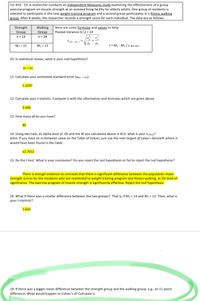
MATLAB: An Introduction with Applications
6th Edition
ISBN: 9781119256830
Author: Amos Gilat
Publisher: John Wiley & Sons Inc
expand_more
expand_more
format_list_bulleted
Question
Just question 19 please

Transcribed Image Text:For #10 - 19: A researcher conducts an Independent-Measures study examining the effectiveness of a group
exercise program on muscle strength at an assisted living facility for elderly adults. One group of residents is
selected to participate in the new weight training program and a second group participates in a fitness walking
group. After 8 weeks, the researcher records a strength score for each individual. The data are as follows:
Strength
Walking
Here are some formulas and values to help:
Pooled Variance (s?,) = 14
Group
Group
n = 14
n = 28
S(M1-M2)
V n
n,
M1 = 15
M2 = 12
t = M1 - M2 / S (M1-M2)
10. In statistical notion, what is your null hypothesis?
µ1 = µ2
11. Calculate your estimated standard error (SM1- M2).
1.2247
12. Calculate your t-statistic. Compute it with the information and formulas which are given above.
2.449
13. How many df do you have?
40
14. Using two tails, an alpha level of .05 and the df you calculated above in #13, what is your tcritical?
(Hint: If you have an in-between value on the Table of Values, just use the next largest df value-beneath where it
would have been found in the table.
+2.7012
15. Do the t-test. What is your conclusion? Do you reject the null hypothesis or fail to reject the null hypothesis?
There is enough evidence to conclude that there is significant difference between the population mean
strength scores for the residents who are reselected to weight training program and fitness walking, at 5% level of
significance. The exercise program of muscle strength is significantly effective. Reject the null hypothesis.
16. What if there was a smaller difference between the two groups? That is, if M1 = 14 and M2 = 12. Then, what is
your t-statistic?
1.633
19. If there was a bigger mean difference between the strength group and the walking group, e.g., an 11-point
difference. What would happen to Cohen's d? Calculate it.
Expert Solution
This question has been solved!
Explore an expertly crafted, step-by-step solution for a thorough understanding of key concepts.
Step by stepSolved in 2 steps

Knowledge Booster
Similar questions
arrow_back_ios
SEE MORE QUESTIONS
arrow_forward_ios
Recommended textbooks for you
 MATLAB: An Introduction with ApplicationsStatisticsISBN:9781119256830Author:Amos GilatPublisher:John Wiley & Sons Inc
MATLAB: An Introduction with ApplicationsStatisticsISBN:9781119256830Author:Amos GilatPublisher:John Wiley & Sons Inc Probability and Statistics for Engineering and th...StatisticsISBN:9781305251809Author:Jay L. DevorePublisher:Cengage Learning
Probability and Statistics for Engineering and th...StatisticsISBN:9781305251809Author:Jay L. DevorePublisher:Cengage Learning Statistics for The Behavioral Sciences (MindTap C...StatisticsISBN:9781305504912Author:Frederick J Gravetter, Larry B. WallnauPublisher:Cengage Learning
Statistics for The Behavioral Sciences (MindTap C...StatisticsISBN:9781305504912Author:Frederick J Gravetter, Larry B. WallnauPublisher:Cengage Learning Elementary Statistics: Picturing the World (7th E...StatisticsISBN:9780134683416Author:Ron Larson, Betsy FarberPublisher:PEARSON
Elementary Statistics: Picturing the World (7th E...StatisticsISBN:9780134683416Author:Ron Larson, Betsy FarberPublisher:PEARSON The Basic Practice of StatisticsStatisticsISBN:9781319042578Author:David S. Moore, William I. Notz, Michael A. FlignerPublisher:W. H. Freeman
The Basic Practice of StatisticsStatisticsISBN:9781319042578Author:David S. Moore, William I. Notz, Michael A. FlignerPublisher:W. H. Freeman Introduction to the Practice of StatisticsStatisticsISBN:9781319013387Author:David S. Moore, George P. McCabe, Bruce A. CraigPublisher:W. H. Freeman
Introduction to the Practice of StatisticsStatisticsISBN:9781319013387Author:David S. Moore, George P. McCabe, Bruce A. CraigPublisher:W. H. Freeman

MATLAB: An Introduction with Applications
Statistics
ISBN:9781119256830
Author:Amos Gilat
Publisher:John Wiley & Sons Inc

Probability and Statistics for Engineering and th...
Statistics
ISBN:9781305251809
Author:Jay L. Devore
Publisher:Cengage Learning

Statistics for The Behavioral Sciences (MindTap C...
Statistics
ISBN:9781305504912
Author:Frederick J Gravetter, Larry B. Wallnau
Publisher:Cengage Learning

Elementary Statistics: Picturing the World (7th E...
Statistics
ISBN:9780134683416
Author:Ron Larson, Betsy Farber
Publisher:PEARSON

The Basic Practice of Statistics
Statistics
ISBN:9781319042578
Author:David S. Moore, William I. Notz, Michael A. Fligner
Publisher:W. H. Freeman

Introduction to the Practice of Statistics
Statistics
ISBN:9781319013387
Author:David S. Moore, George P. McCabe, Bruce A. Craig
Publisher:W. H. Freeman